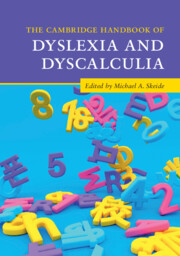Book contents
- The Cambridge Handbook of Dyslexia and Dyscalculia
- The Cambridge Handbook of Dyslexia and Dyscalculia
- Copyright page
- Contents
- Figures and Tables
- Contributors
- Acknowledgements
- General Introduction
- Part I Theoretical Frameworks and Computational Models
- Part II Cognitive Profiles and Behavioural Manifestations
- Part III Genetic and Environmental Influences
- Part IV Neurodevelopmental Foundations
- 8 Neurogenetic Insights into the Origins of Dyslexia and Dyscalculia
- 9 Longitudinal Neural Observation Studies of Dyslexia
- 10 Longitudinal Neural Observation Studies of Dyscalculia
- 11 Neuroplasticity in Response to Reading Intervention
- 12 Neuroplasticity in Response to Mathematical Intervention
- Summary: Neurodevelopmental Foundations
- Part V Gender, Ethnicity, and Socioeconomic Background
- Part VI Cultural Unity and Diversity
- Part VII Early Prediction
- Part VIII Intervention and Compensation
- Part IX Best Practice – Diagnostics and Prevention
- Part X Best Practice – Schooling and Educational Policy
- General Summary
- References
- Index
- References
11 - Neuroplasticity in Response to Reading Intervention
from Part IV - Neurodevelopmental Foundations
Published online by Cambridge University Press: 28 July 2022
- The Cambridge Handbook of Dyslexia and Dyscalculia
- The Cambridge Handbook of Dyslexia and Dyscalculia
- Copyright page
- Contents
- Figures and Tables
- Contributors
- Acknowledgements
- General Introduction
- Part I Theoretical Frameworks and Computational Models
- Part II Cognitive Profiles and Behavioural Manifestations
- Part III Genetic and Environmental Influences
- Part IV Neurodevelopmental Foundations
- 8 Neurogenetic Insights into the Origins of Dyslexia and Dyscalculia
- 9 Longitudinal Neural Observation Studies of Dyslexia
- 10 Longitudinal Neural Observation Studies of Dyscalculia
- 11 Neuroplasticity in Response to Reading Intervention
- 12 Neuroplasticity in Response to Mathematical Intervention
- Summary: Neurodevelopmental Foundations
- Part V Gender, Ethnicity, and Socioeconomic Background
- Part VI Cultural Unity and Diversity
- Part VII Early Prediction
- Part VIII Intervention and Compensation
- Part IX Best Practice – Diagnostics and Prevention
- Part X Best Practice – Schooling and Educational Policy
- General Summary
- References
- Index
- References
Summary
Understanding the neurobiological underpinnings of learning difficulties, particularly developmental dyslexia, has received substantial attention since functional MRI and diffusion MRI first became widely available in the 1990s. Now, a couple decades later, there are hundreds of studies documenting differences in brain structure and function in people with dyslexia. Despite vast differences in educational systems, writing systems, and languages around the world, and differences in methodologies and samples across labs, there are at least three points that are broadly accepted.
- Type
- Chapter
- Information
- The Cambridge Handbook of Dyslexia and Dyscalculia , pp. 202 - 211Publisher: Cambridge University PressPrint publication year: 2022



